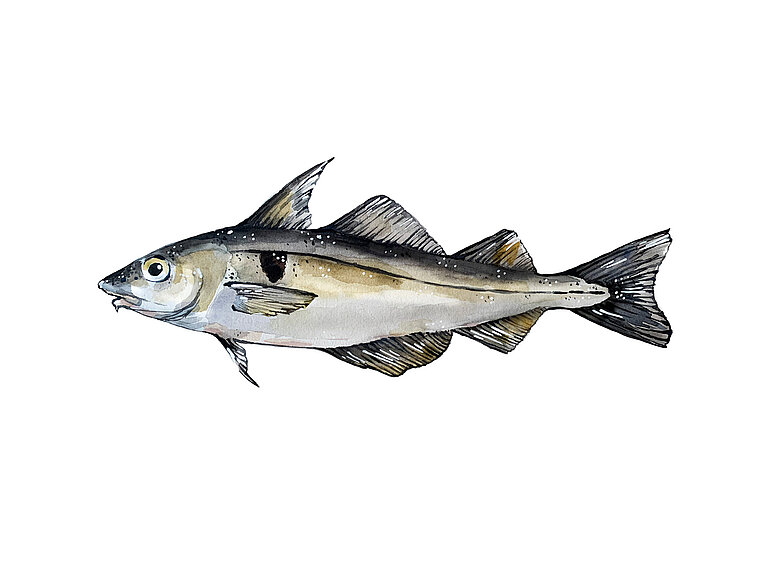‘Good fish’ for Christmas
Research institutions, environmental associations and consumer centres update the joint ‘Good Fish’ list for conscious purchasing of sea fish
– Joint press release of the German Consumer Advice Centres, GEOMAR Helmholtz Centre for Ocean Research Kiel, Deutsche Umwelthilfe, Naturschutzbund Deutschland and World Wide Fund For Nature –
Christmas is just around the corner and with it the question of what to eat for the festive season. Fish is particularly popular, but ‘good fish’ is becoming increasingly hard to find. Overfishing, habitat destruction and high bycatch levels are making it increasingly difficult to make sustainable choices when shopping. This is why Deutsche Umwelthilfe e.V. (DUH), GEOMAR Helmholtz Centre for Ocean Research Kiel, Naturschutzbund Deutschland e.V. (NABU), the World Wide Fund For Nature (WWF) and the consumer advice centres have updated the joint ‘Good Fish’ list. To make a good choice, consumers, retailers and restaurant operators should prioritise buying fish and shellfish that comply with the list.
Significant deterioration in the state of herring stocks
After mackerel and sprat had to be removed from the list last year, the state of herring stocks has now deteriorated significantly. Herring from the North Sea and the northern Irish Sea should no longer be eaten at all, while Baltic herring from the Gulf of Riga is only recommended to a limited extent. The once highly recommended salmon stocks in Alaska are also a cause for concern, meaning that sockeye salmon is no longer recommended and chum salmon is only conditionally recommended.
Dr Rainer Froese, marine ecologist and fisheries scientist at the GEOMAR Helmholtz Centre for Ocean Research Kiel, explains: ‘Unfortunately, it is becoming increasingly difficult to find sustainable stocks for the “Good Fish” list, as the overfishing of our seas continues. A sad example is the North Sea herring: last year it was already only on the list as ‘conditionally recommended’ and yet catches are once again far too high. The stock continued to shrink and consequently had to be completely removed from the list.’
Isabel Seeger, Isabel Seeger, marine conservation officer at Deutsche Umwelthilfe, explains: ‘In addition to the ongoing overfishing, oxygen depletion and the climate crisis are affecting fish stocks. The poor environmental status of the seas is also hindering the recovery of already overfished stocks, such as the decimated Baltic cod, one of the former ‘bread and butter’ fish of our Baltic Sea fisheries.’
Dr. Kim Detloff, NABU Head of Marine Conservation, demands: ‘Fish populations are collapsing, fishing companies are giving up. The fisheries policy of recent years has failed. We finally need ecosystem-based fisheries management, focussed on sustainability and quality rather than short-term economic interests. When ‘good fish’ ends up on our plates, consumers make an important contribution to this.’
Dr. Philipp Kanstinger, WWF fisheries expert, adds: ‘It is worrying that herring, sprat and mackerel are no longer fully recommended. In a healthy ecosystem, these small schooling fish would be abundant and therefore both a sustainable choice for consumers and a food source for seabirds, harbour porpoises, seals and larger fish that rely on them for food. Instead, these species continue to be overfished, with the catches often being fed to farmed animals as fishmeal.’
Demand helps determine what the market delivers. Sustainable purchasing decisions can therefore help to influence the environmental impact of fishing. When asked by the most important retailers and suppliers of fish products, Rewe and Edeka replied that they have some tinned tuna products in their range that fulfil the criteria of the Good Fish List. Netto offers a frozen product containing chum salmon, which is conditionally recommended, while Frosta refers to some Alaska pollock products that fulfil the requirements for the most part.
Dr. Britta Schautz, Food and nutrition expert at the Berlin Consumer Advice Centre: ‘Many consumers like to eat fish and are generally aware of the problem of overfishing. But they lack concrete information about which stocks are affected. With the help of this list, everyone can easily decide for themselves which fish can still end up on the table at Christmas.’
How the list works
For unprocessed fish and frozen products, information on the fish species, fishing method and fishing area is mandatory. These should be carefully compared with the list to ensure that no fish from a highly endangered stock ends up in your shopping trolley. However, the labelling required by law is not always sufficiently detailed to be able to assess whether a product is ‘good fish’. If in doubt, it is advisable to make specific enquiries.
In addition to the origin, the fishing method is an important criterion. Different gear has different effects on stocks, the seabed and other animals in the ecosystem. Bottom trawls are often particularly harmful, as they have a large by-catch and destroy the seabed. Despite this, they are still used in many places, even in marine protected areas.

Cod is a popular edible fish. It is now considered to be overfished. Researchers at GEOMAR regularly study the fish stocks in the Baltic Sea. Photo: Sarah Uphoff, GEOMAR

The list of “good fish” has become shorter once again. However, the stock of haddock has increased in some regions. This year it is considered “recommended” for the first time. In order to avoid overfishing within a few years, the stock must be managed sustainably. Illustration: Sarah Fricke


